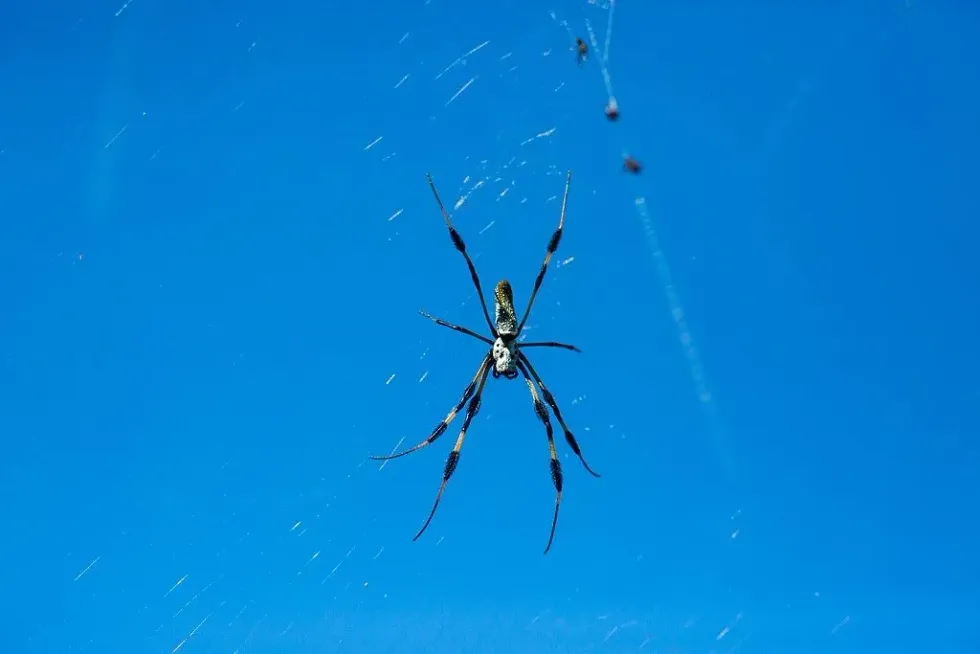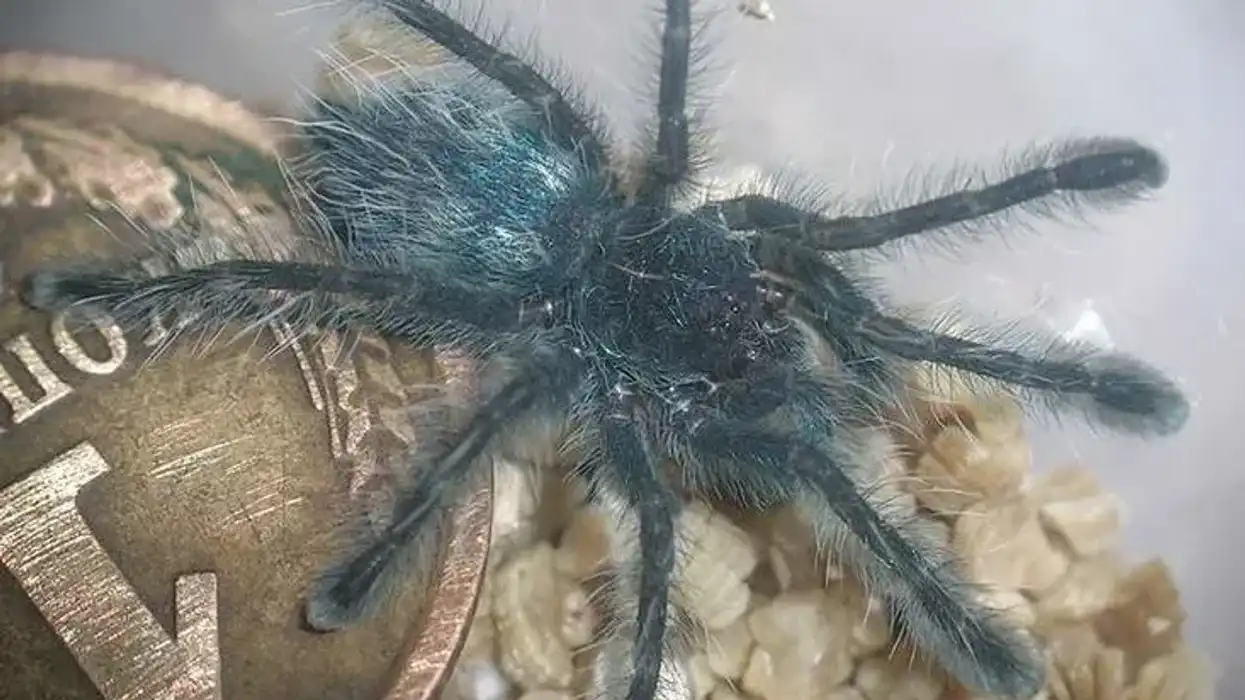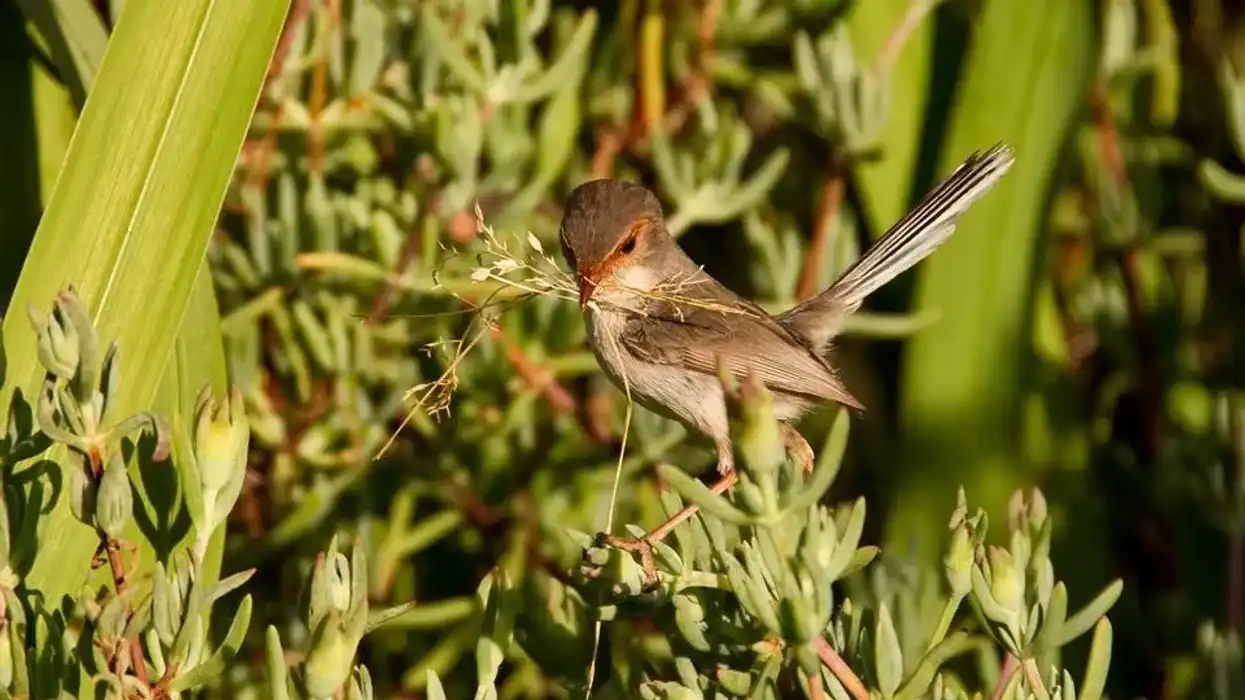The golden silk orb-weaver, scientifically known as Trichonephila clavipes, belongs to the genus Trichonephila. Previously this orb-weaving Trichonephila was discovered by Friedrich Dahl as a species under the Niphela genus. However, in 2019 Trichonephila was uplifted as a separate genus. It is also known as the golden silk spider or banana spider.
They are possibly are the world's largest orb-weaver species found in the United States. Their bite is less toxic. In addition, their silk is believed to be five times stronger than steel.
Golden silk orb-weaver spiders are sexually dimorphic, and females have distinct coloring and are larger than males. The male golden silk orb-weaver spider exhibits mate-searching behavior. Many species of the Araneidae family have striped legs to serve the purpose of weaving.
Check out our wolf spider interesting facts and yellow sac spider fun facts too!
Golden Silk Orb-weaver Interesting Facts
What type of animal is a golden silk orb-weaver?
The golden silk orb-weaver of the genus Trichoniphela is a spider. It is known for its web that shines like a golden silk thread in light.
What class of animal does a golden silk orb-weaver belong to?
Formally known as the Nephila clavipes spider, and now known as the Trichonephila clavipes spider, this spider is an arthropod. It belongs to the class Arachnida.
How many golden silk orb-weavers are there in the world?
The exact population of this orb-weaver spider species is unknown as it is widespread in its range.
Where do golden silk orb-weavers live?
The golden silk orb-weaver prefers woods, dense forests, and shrublands. They are endemic to North and South America. Their range extends from Mexico to Panama, covering Florida and North Carolina, and Gulf states in Central America. In addition, these spiders extend their scope up to Argentina in South America and cover parts of Eastern Canada.
What is a golden silk orb-weaver's habitat?
This spider constructs an orb-web amidst trees and shrubs. The habitat plays a vital role in the lifestyle of these orb-weaving spiders. They are found in abundance in summer as they cannot survive winters.
Who does a golden silk orb-weaver live with?
Female golden orb-weavers are undoubtedly solitary as they mostly remain on their web: males travel across the webs for mating and survival.
How long does a golden silk orb-weaver live?
More generally, golden orb-weavers are recorded to live a lifespan of up to one and half years in the wild, extending to two years in captivity.
How do they reproduce?
Some male spiders can only mate once due to sexual cannibalism behavior and genital mutilation. Thus, forcing these spiders to have a monogynous relation.
However, this species from the genus Trichiniphela doesn't have these issues. But still, the capacity to forage female webs and resist competition from other males contributes to settling for a monogynous pair.
Also, the male produces a limited amount of sperm, sometimes limited to a single mating which can also become a reason for staying in the same relation for the rest of its life.
Smaller male spiders who cannot compete with large spiders have to invest in mating successfully with the female on her web, allowing them to search for the new web. In comparison, larger males favor establishing relations with females in the new web, guarding her until a new search begins.
The female lays eggs on the silk spectrum and wraps them with a soft silk sac. Each golden silk orb-weaver egg sac contains 300-3000 eggs.
What is their conservation status?
Golden silk orb-weavers (T. clavipes) are listed as a species of Least Concern by the International Union for Conservation of Nature.
Golden Silk Orb-weaver Fun Facts
What do golden silk orb-weavers look like?
The golden silk orb-weaver is a species of orb-weaving spiders of the Trichonephila genus.
This species exhibits significant sexual dimorphism in color and size. Female golden silk orb-weavers are giant spiders of the non-tarantula group. The length of these spiders is 0.9-1.5 in (24-40 mm). They also have a distinct coloring that gives this species a unique identity.
The cephalothorax is silvery-white, and the abdomen is orange-brown, and two rows of minute white-yellow spots run across the abdomen, and the color of the abdomen changes as the spider grows.
The first, second, and fourth legs of this banana spider have brush-like hair near the joints, and all the legs of this spider are dark yellow with brown banding.
The average male banana spider size is about one-third or one-fourth of the female, which is 0.2 in (6mm), and the weight is negligible. The male has a dark brown body and legs.
In addition, the legs of the male spider have black banding, unlike the females' tufts of hair at the joints. This brown-black gives warning cues of predators.

How cute are they?
These spiders are not as dangerous as other species that are also described as banana spiders as they are less venomous. These golden orb-weavers are reasonable about their webs and stay in them permanently and maintain them well.
How do they communicate?
With their dominating size and web weaving capacity, females remain solitary. Still, the significant need to establish a bond is bestowed to males of the species as they are at higher risk of becoming prey.
Once a male bonds with a female, he has to continue the bond with the same female and guard her against benefiting from the web.
How big is a golden silk orb-weaver?
The length of a Trichonephila (previously known as Nephila) golden silk orb-weaver ranges from 0.9-1.6 in (24-40 mm), twice as small as the average Nephila genus spider, whose length is 1.5-2 in (4.8-5.1 cm).
How fast can a golden silk orb-weaver move?
These spiders are not good runners but can be race-winning jumpers. They can jump to a distance equal to 40 times their weight.
How much does a golden silk orb-weaver weigh?
The average weight of this type of golden orb-weaver is less than 0.14 oz.
What are the male and female names of the species?
Male and female orb-weaving spiders are called male golden silk orb-weavers and female golden silk orb-weavers, and their group is called a clutter or cluster.
What would you call a baby golden silk orb-weaver?
A baby silk orb-weaver is called a spiderling. Spiderlings leave the egg sac during the ideal warmer and wetter environments of spring.
What do they eat?
The diet of these spiders contains bees, flies, beetles, wasps, butterflies, dragonflies, and tiny moths. The golden silk orb-weaver's web is a hunting weapon for this species that was formerly classified under the Nephila genus. Most of the time, flying insects get caught into this web, allowing these spiders to get hold of their prey.
Are they poisonous?
The golden silk orb-weaver (formerly known as Nephila clavipes but now known as Trichonephila clavipes) is toxic. Their venom can subdue their prey (including insects) but is less effective on humans.
Would they make a good pet?
These golden silk orb-weaver or banana spiders can be kept as pets under the right conditions. However, their presence could be harmful to fellow animal pets, and they require a room large enough for them to spin their webs, so all of this must be taken into account.
Did you know...
Their former genus name Nephila refers to an Ancient Greek word that means 'fond of spinning'.
In Latin, 'clavipes' means 'club-footed' as 'clava' means 'clubbed', and 'pes' refers to 'foot'.
These spiders remain permanently in their webs. The webs are very complex and are outlined and barrier webs. The purpose of barrier webs is to alert the spider about the arrival of predators.
The giant golden orb-weaver (previously from the genus Nephila) is an enormous orb-web spider with a length of 1.6 in (42 mm).
Can a golden orb spider kill you?
These banana spiders of the Trichonephola genus are not completely harmless as on contact they might bite, which will cause a local irritation that will last for less than a day. The toxicity of their venom does not often cause significant side effects in humans.
How do their webs work?
These banana spiders produce large spider silk webs which are asymmetric.
The golden silk orb-weaver large web is asymmetric with a diameter that varies from 39.3-78.7 in (99.8-199.8 cm). The filament that anchors the web between trees varies from 78.7-118 in (199.8-299.7 cm).
The rich golden glow that reflects on lighting account for the bright yellow pigment in the silk. The golden silk orb-weaver spider uses seven glands of silk in it's web construction.
High tensile strengthened major ampullate silk is used in draglines, radii of the web, and bridge lines. Scaffolding is held by minor ampullate silk.
The bonding of fibers and other structures in the web is done by cement-like piriform silk. The Aciniform silk, as strong as major ampullate, is used in prey wrapping and insulating egg cases. Tough outer shell cases of eggs are formed from Tubuliform silk.
Finally, the stickiness and stretching of the aggregate and flagelliform silk are useful in prey capture. All these seven silks have different spidroin proteins.
Here at Kidadl, we have carefully created lots of interesting family-friendly animal facts for everyone to discover! For more relatable content, check out these garden spider facts and brown-recluse spider facts pages.
You can even occupy yourself at home by coloring in one of our free printable golden silk orb-weaver coloring pages.










